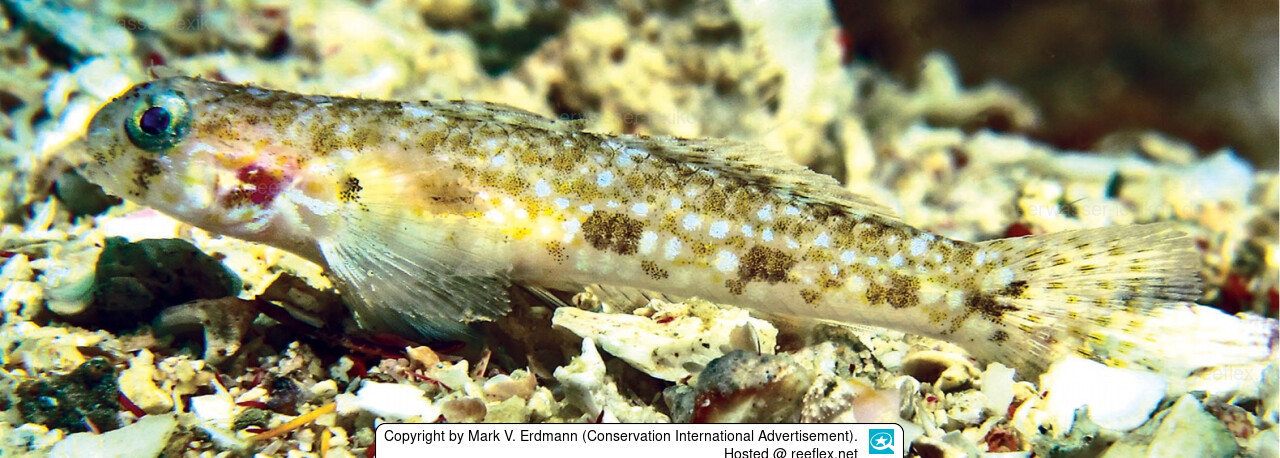Info
Similar species: Istigobius spence (Smith, 1947)
Istigobius murdyi is a deep-water goby that became known almost simultaneously from two areas and was first described in 2018 by Dr. Mark Erdmann and Dr. Douglass F. Hoese.
While the holotype of this goby was collected in Misool, Raja Ampat, West Papua, Indonesia, all paratypes originated from Sherman Sled, Rowley Shoals, North West Shelf, Western Australia.
When two specimens are found in locations that are geographically far apart, the question often arises as to which of these locations was home to the first pair, the age-old question of whether the egg or the hen came first.
With two locations so far apart, the question arises as to which of these locations the first pair came from, the age-old question of whether the egg or the hen came first.
Around Raja Ampat, the goby was found on a gentle slope with a mixed sand and small coral rubble substrate, which was exposed to currents and lower temperatures due to cold water upwelling.
Citation:
Hoese, D.F. & Erdmann, M.V. (2018) Description of a new species of Istigobius (Teleostei: Gobiidae) from Australia and Indonesia.
Journal of the Ocean Science Foundation, 30, 70–77
doi: http://dx.doi.org/10.5281/zenodo.1291469
urn:lsid:zoobank.org:pub:B3A8358B-A086-4A37-B618-A58FA84EB20C
Date of publication of this version of record:
15 June 2018
Jumping guard
A jumping guard prevents (nocturnal) fish from jumping out.
Wrasses, blennies, hawkfishs and gobies jump out of an unprotected tank in fright if their night rest is disturbed, unfortunately these jumpers are found dried up in the morning on carpets, glass edges or later behind the tank.
https://www.korallenriff.de/en/article/1925_5_Jump_Protection_Solutions_for_Fish_in_the_Aquarium__5_Net_Covers.html
A small night light also helps, as it provides the fish with a means of orientation in the dark!
Istigobius murdyi is a deep-water goby that became known almost simultaneously from two areas and was first described in 2018 by Dr. Mark Erdmann and Dr. Douglass F. Hoese.
While the holotype of this goby was collected in Misool, Raja Ampat, West Papua, Indonesia, all paratypes originated from Sherman Sled, Rowley Shoals, North West Shelf, Western Australia.
When two specimens are found in locations that are geographically far apart, the question often arises as to which of these locations was home to the first pair, the age-old question of whether the egg or the hen came first.
With two locations so far apart, the question arises as to which of these locations the first pair came from, the age-old question of whether the egg or the hen came first.
Around Raja Ampat, the goby was found on a gentle slope with a mixed sand and small coral rubble substrate, which was exposed to currents and lower temperatures due to cold water upwelling.
Citation:
Hoese, D.F. & Erdmann, M.V. (2018) Description of a new species of Istigobius (Teleostei: Gobiidae) from Australia and Indonesia.
Journal of the Ocean Science Foundation, 30, 70–77
doi: http://dx.doi.org/10.5281/zenodo.1291469
urn:lsid:zoobank.org:pub:B3A8358B-A086-4A37-B618-A58FA84EB20C
Date of publication of this version of record:
15 June 2018
Jumping guard
A jumping guard prevents (nocturnal) fish from jumping out.
Wrasses, blennies, hawkfishs and gobies jump out of an unprotected tank in fright if their night rest is disturbed, unfortunately these jumpers are found dried up in the morning on carpets, glass edges or later behind the tank.
https://www.korallenriff.de/en/article/1925_5_Jump_Protection_Solutions_for_Fish_in_the_Aquarium__5_Net_Covers.html
A small night light also helps, as it provides the fish with a means of orientation in the dark!







 Dr. Mark V. Erdmann (Conservation International Advertisement), Indonesien
Dr. Mark V. Erdmann (Conservation International Advertisement), Indonesien












